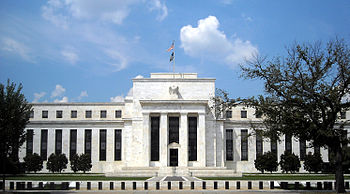
In macroeconomics, sterilization is action taken by a country's central bank to counter the effects on the money supply caused by a balance of payments surplus or deficit.[1] This can involve open market operations undertaken by the central bank whose aim is to neutralize the impact of associated foreign exchange operations.[2] The opposite is unsterilized intervention, where monetary authorities have not insulated their country's domestic money supply and internal balance against foreign exchange intervention.[citation needed]
Sterilization is most often used in the context of a central bank that takes actions to negate potentially harmful impacts of capital inflows – such as currency appreciation and inflation – both of which can reduce export competitiveness. More generally, it may refer to any form of monetary policy which seeks to hold the domestic money supply unchanged despite external shocks or other changes, including the flow of capital out of the relevant area (generally, a country).
In the second half of the 20th century, sterilization was sometimes associated with efforts by monetary authorities to "defend" the value of their currency. In the 1930s and in the 21st century, sterilization has most commonly been associated with efforts by nations with a balance of payments surplus to prevent currency appreciation.
- ^ Sloman, John (2004). Economics. Penguin. p. 969. ISBN 0-7450-1333-3.
- ^ Paul Krugman and Maurice Obstfeld, "International Economics, Theory and Policy", Addison Wesley, 2003, 6th Edition, pgs. 488–489